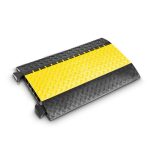Overview
Introduction to ADA compliance for public parking lots
Public parking lots play a crucial role in providing accessible transportation options for individuals with disabilities. In order to ensure equal access and comply with the Americans with Disabilities Act (ADA), it is essential for public parking lots to meet certain standards of accessibility. This article aims to explore the role of parking blocks in ADA compliance for public parking lots, highlighting their importance in creating accessible parking spaces for individuals with disabilities. By understanding the significance of parking blocks and their impact on ADA compliance, public parking lot owners and managers can take the necessary steps to improve accessibility and provide equal opportunities for all individuals.
Importance of parking blocks in ADA compliance
The importance of parking blocks in ADA compliance cannot be overstated. These blocks serve as a crucial element in ensuring that public parking lots are accessible to individuals with disabilities. By providing a designated space for parking, they enable people with mobility impairments to safely and conveniently access public facilities. Moreover, these blocks also help in preventing unauthorized parking in accessible spaces, thereby ensuring that they are available for those who truly need them. Overall, parking blocks play a vital role in promoting inclusivity and equal access for all individuals in public parking lots.
Overview of the article
The article titled ‘The Role of Parking Blocks in ADA Compliance for Public Parking Lots’ provides an in-depth analysis of the importance of parking blocks in ensuring ADA compliance in public parking lots. The article begins with an overview of ADA (Americans with Disabilities Act) regulations and the specific requirements for accessible parking spaces. It then delves into the role of parking blocks in providing guidance and protection for individuals with disabilities. The article highlights the various features and characteristics of ADA-compliant parking blocks, such as size, color contrast, and accessibility signage. Additionally, it explores the benefits of utilizing these parking blocks, including improved safety, convenience, and equal access for all individuals. Overall, this article serves as a comprehensive resource for understanding the significance of parking blocks in achieving ADA compliance in public parking lots.
Understanding ADA Compliance
Explanation of the Americans with Disabilities Act (ADA)
The Americans with Disabilities Act (ADA) is a federal law that prohibits discrimination against individuals with disabilities. It was enacted in 1990 and has since been amended to ensure equal access and opportunities for people with disabilities. The ADA covers a wide range of areas, including employment, public accommodations, transportation, and telecommunications. In the context of public parking lots, the ADA requires compliance with specific guidelines to ensure accessibility for individuals with disabilities. One important aspect of ADA compliance for public parking lots is the use of parking blocks, also known as wheel stops or parking bumpers. These blocks help create designated accessible parking spaces and ensure that vehicles do not encroach on the required space. By providing clear demarcation and preventing unauthorized parking, parking blocks play a crucial role in promoting accessibility and ensuring ADA compliance in public parking lots.
Requirements for ADA compliance in public parking lots
In order to ensure ADA compliance in public parking lots, there are specific requirements that must be met. One of the key requirements is the provision of accessible parking spaces. These spaces must be designated with the International Symbol of Accessibility and be located in close proximity to the accessible entrances of the building or facility. Additionally, there must be a sufficient number of accessible parking spaces based on the total number of parking spaces provided. The dimensions of the accessible parking spaces, including the width and length, must also adhere to the ADA standards. Furthermore, there should be an accessible route from the accessible parking spaces to the accessible entrances, which should be free from any obstructions or barriers. By meeting these requirements, public parking lots can ensure accessibility for individuals with disabilities and promote inclusivity.
Key considerations for ADA compliance
When it comes to ensuring ADA compliance in public parking lots, there are several key considerations that must be taken into account. One of the most important considerations is the use of parking blocks. These blocks play a crucial role in providing accessible parking spaces for individuals with disabilities. The height, width, and placement of parking blocks must meet specific ADA guidelines to ensure easy access and maneuverability for wheelchair users. Additionally, parking blocks should be properly painted and marked to clearly indicate accessible parking spaces. By carefully considering these factors, public parking lots can ensure that they are meeting ADA compliance standards and providing equal access for all individuals.
Role of Parking Blocks
Definition and purpose of parking blocks
Parking blocks, also known as wheel stops or parking curbs, are physical barriers placed at the end of parking spaces to prevent vehicles from overhanging or encroaching onto walkways, sidewalks, or adjacent parking spaces. The purpose of parking blocks is to ensure proper parking alignment and to enhance safety in public parking lots. By clearly marking the boundaries of parking spaces, parking blocks help drivers park their vehicles within the designated area, reducing the risk of accidents and improving traffic flow. Additionally, parking blocks play a crucial role in ADA compliance by providing a visual and physical indicator for drivers with disabilities, helping them navigate parking lots and access facilities with ease. Overall, parking blocks serve as an essential tool in maintaining order, organization, and accessibility in public parking areas.
How parking blocks contribute to ADA compliance
Parking blocks play a crucial role in ensuring ADA compliance for public parking lots. These blocks are specifically designed to provide guidance and support for individuals with disabilities. By strategically placing parking blocks in designated accessible parking spaces, it helps drivers with disabilities to easily identify and navigate these areas. Additionally, the raised surface of the parking blocks serves as a tactile indicator, assisting visually impaired individuals in locating and safely maneuvering within the parking lot. The presence of parking blocks also helps prevent unauthorized vehicles from encroaching on accessible parking spaces, ensuring that they are always available for those who need them. Overall, parking blocks contribute significantly to creating an inclusive and accessible environment for individuals with disabilities in public parking lots.
Types of parking blocks suitable for ADA compliance
There are several types of parking blocks that are suitable for ADA compliance in public parking lots. One common type is the concrete parking block, which is durable and provides a clear visual indicator for drivers. These blocks are typically painted with bright colors and have high contrast striping to ensure visibility for individuals with visual impairments. Another type is the rubber parking block, which is more flexible and can absorb impact from vehicles. Rubber blocks are often used in areas where there is a higher risk of vehicle collisions, such as near entrances and exits. Additionally, there are also recycled plastic parking blocks available, which are lightweight and environmentally friendly. These blocks are made from recycled materials and are easy to install and maintain. Overall, the different types of parking blocks offer various benefits and can be chosen based on the specific needs and requirements of the public parking lot.
Installation and Placement
Proper installation of parking blocks
Proper installation of parking blocks is crucial to ensure ADA compliance in public parking lots. These blocks serve as a physical barrier between parking spaces, preventing vehicles from encroaching into designated accessible areas. When installed correctly, parking blocks provide clear guidance for drivers, ensuring that accessible parking spaces are easily identifiable and available for individuals with disabilities. It is important to follow the guidelines provided by the ADA to ensure proper placement, height, and visibility of parking blocks. Additionally, regular maintenance and inspection of parking blocks is essential to ensure they remain in good condition and continue to meet ADA requirements. By prioritizing the proper installation of parking blocks, public parking lots can create a more inclusive and accessible environment for all individuals.
Guidelines for placement of parking blocks in public parking lots
When it comes to the placement of parking blocks in public parking lots, there are several guidelines that should be followed to ensure ADA compliance. First and foremost, it is important to ensure that parking blocks are placed in a way that does not obstruct the accessible parking spaces designated for individuals with disabilities. These spaces should be clearly marked and easily accessible. Additionally, the height and dimensions of the parking blocks should meet the ADA requirements to ensure safe and convenient use for all individuals. It is also important to consider the placement of parking blocks in relation to curb ramps and accessible routes, ensuring that they do not create any barriers or obstacles for individuals with disabilities. By following these guidelines, public parking lots can ensure that their parking blocks are in compliance with ADA regulations, providing equal access and convenience for all individuals.
Common mistakes to avoid during installation
During the installation of parking blocks, there are several common mistakes that should be avoided to ensure ADA compliance. One of the most common mistakes is improper placement of the blocks, which can create barriers for individuals with disabilities. It is important to follow the guidelines provided by the ADA to ensure that the parking blocks are installed at the correct height and distance from each other. Another mistake to avoid is using blocks that are not slip-resistant, as this can pose a safety hazard. Additionally, it is crucial to properly secure the blocks to the ground to prevent them from shifting or becoming loose over time. By avoiding these common mistakes, public parking lots can ensure that they are providing accessible parking spaces for all individuals.
Maintenance and Accessibility
Regular maintenance of parking blocks for ADA compliance
Regular maintenance of parking blocks is essential for ensuring ADA compliance in public parking lots. These blocks play a crucial role in providing accessible parking spaces for individuals with disabilities. Over time, parking blocks may become damaged or worn out, posing potential hazards to disabled individuals who rely on them for safe and convenient parking. Therefore, it is important for parking lot owners and managers to regularly inspect and repair parking blocks to ensure they meet the required standards. This includes checking for any cracks, uneven surfaces, or fading paint that may hinder accessibility. By prioritizing the regular maintenance of parking blocks, public parking lots can create a safe and inclusive environment for all individuals, regardless of their mobility needs.
Ensuring accessibility for individuals with disabilities
Ensuring accessibility for individuals with disabilities is a crucial aspect of creating inclusive public spaces. One important element in achieving this goal is the proper implementation of parking blocks in public parking lots. Parking blocks, also known as wheel stops, play a significant role in ADA compliance by providing guidance and protection for individuals with disabilities. These blocks are strategically placed to ensure that accessible parking spaces are clearly delineated and reserved for those who need them. By installing and maintaining parking blocks in accordance with ADA guidelines, public parking lots can effectively support the mobility and independence of individuals with disabilities, allowing them equal access to essential services and facilities.
Addressing issues and repairs
Addressing issues and repairs in public parking lots is crucial for ensuring ADA compliance. One of the key aspects to consider is the installation of parking blocks. These blocks play a vital role in providing guidance and accessibility for individuals with disabilities. By clearly marking parking spaces and preventing unauthorized vehicles from encroaching into designated areas, parking blocks help create a safe and inclusive environment. Additionally, regular inspections and maintenance of parking blocks are essential to address any issues or damages promptly. This proactive approach ensures that public parking lots meet the necessary standards and provide equal access to all individuals, regardless of their abilities.
Conclusion
Summary of the importance of parking blocks in ADA compliance
Parking blocks play a crucial role in ensuring ADA compliance for public parking lots. These blocks are designed to provide guidance and assistance to individuals with disabilities, particularly those who have mobility challenges. By clearly marking parking spaces and providing a physical barrier between parking areas and pedestrian walkways, parking blocks help prevent unauthorized parking and ensure that accessible spaces are reserved for those who need them. Additionally, the contrasting colors and reflective surfaces of parking blocks make them highly visible, further enhancing safety for all users. Overall, the presence of well-maintained and properly installed parking blocks is essential in promoting inclusivity and accessibility in public parking lots.
Key takeaways from the article
The article titled ‘The Role of Parking Blocks in ADA Compliance for Public Parking Lots’ provides valuable insights into the importance of parking blocks in ensuring ADA compliance in public parking lots. The key takeaways from the article highlight the significance of properly designed and installed parking blocks in creating accessible parking spaces for individuals with disabilities. It emphasizes the need for parking blocks to meet specific requirements, such as size, height, and color contrast, to ensure visibility and safety. The article also emphasizes the role of proper signage and striping in guiding drivers and ensuring efficient use of parking spaces. Overall, the article emphasizes the crucial role that parking blocks play in promoting inclusivity and accessibility in public parking lots, and it serves as a valuable resource for both parking lot owners and users.
Future considerations for improving ADA compliance in public parking lots
In order to further improve ADA compliance in public parking lots, there are several future considerations that can be taken into account. Firstly, it is important to ensure that there are an adequate number of accessible parking spaces available, based on the size and capacity of the parking lot. Additionally, the layout and design of parking lots should be carefully planned to provide clear pathways and easy access for individuals with disabilities. This can include the use of wider parking spaces, designated accessible routes, and appropriate signage. Furthermore, it is crucial to regularly maintain and inspect parking lots to ensure that accessibility features, such as parking blocks, are in good condition and meet ADA requirements. By continuously evaluating and implementing these future considerations, public parking lots can strive to provide equal access and convenience for all individuals, regardless of their abilities.




